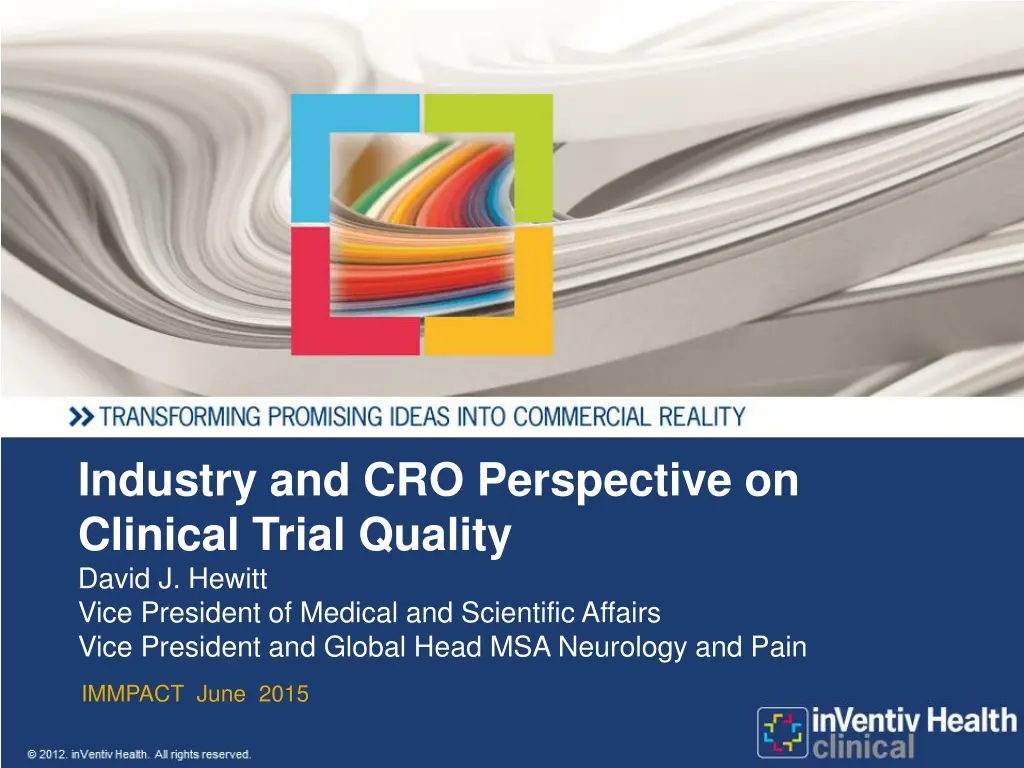
Clinical Trial Quality Perspectives from Industry and CROs
Gain insights into clinical trial quality from industry and CRO perspectives, highlighting the impact of biopharmaceutical companies and contract research organizations on study execution and site quality assurance.
Download Presentation

Please find below an Image/Link to download the presentation.
The content on the website is provided AS IS for your information and personal use only. It may not be sold, licensed, or shared on other websites without obtaining consent from the author. If you encounter any issues during the download, it is possible that the publisher has removed the file from their server.
You are allowed to download the files provided on this website for personal or commercial use, subject to the condition that they are used lawfully. All files are the property of their respective owners.
The content on the website is provided AS IS for your information and personal use only. It may not be sold, licensed, or shared on other websites without obtaining consent from the author.
E N D
Presentation Transcript
Industry and CRO Perspective on Clinical Trial Quality David J. Hewitt Vice President of Medical and Scientific Affairs Vice President and Global Head MSA Neurology and Pain IMMPACT June 2015
Disclosures Currently working for inVentiv Health a CRO/CCO Involved in multiple trials for large and small biopharmaceutical companies Large commercial group that works with multiple biopharmaceutical companies Merck Johnson & Johnson 2
Clinical Trial Quality Overview Quality by Design Need more than a good protocol It all starts with a thorough preclinical assessment Clinical trial design Investigator and Site selection Trial Execution 3
The Biopharmaceutical Companies and Quality Significant time to think, rethink, and reconsider decisions and then things change. Can impact quality Big pharma: Complex decision making process with significant input from hierarchical reporting structure Small pharma: Smaller number of stake holders: VCs, CEO and board may have opinions Money impacts quality of the study Small companies can burn through cash quickly just waiting for FPI Want to be sold or go public Big pharma has the cash, but there are limits Sites might enter patients into higher paying (less complex) studies 4
Contract Research Organizations and Quality Focus is on study execution: quality and speed Doing one thing over and over again should make you good at what you do Project team CROs have benefit of experience running multiple studies in the same area Sponsor may not have steady stream of studies in the area of interest For small companies there is no other way CRAs are where the rubber meets the road. They need to be experienced. Central role in ensuring quality at the site level 5
Contract Research Organizations and Quality Sites: often well known Contracts: experience in working with academic institutions and research sites Regulatory: experience in country specific concerns Scientific input: physicians in particular have a unique opportunity to see how different sponsors approach developing studies for a particular indication Contract Commercial Organization: protocol is reviewed with an understanding of the current market dynamics 6
Quality Clinical Trials Begins with Early Drug Development Portfolio of products requires decision on which compounds to move forward in development Most likely to be safe and effective What mechanisms to pursue Shots on goal versus .. De-risking assets: ensures quality of clinical trials that follow Significant investment in preclinical and early stage development to Demonstrate target engagement Proof of pharmacology Safety Selection of optimum dose range for phase 2 7
Quality Clinical Trials an Ongoing Process Tension between Stopping clinical development early and .. Recognition that a number of successful drugs have required champions and would otherwise been discontinued Drugs tend to collect more adverse events over course of development Clinical development plan and life cycle management Significant focus on de-risking development Focus on customer needs: patient, caregiver, physician, etc Focus on potential need for PROs Health economic considerations Discuss with KOLs Discuss with Patients 8
Clinical Trial Design Focus on choice of primary, co-primaries and secondary endpoints Design study that is fit for new therapy and a specific mechanism QST: not all sites have. Need adequate training for consistency across sites Large number of outcome measures and instruments Provide evidence for payers But patient and site burden can negatively impact the study Protocol complexity is sometimes necessary, but complex studies can negatively impact quality PI will work on less complex study everything else being equal 9
Clinical Trial Design Blind investigator and staff to entry criteria: blind to start of study drug Use of algorithm can decrease variability and blind investigator Adaptive designs should be considered More efficient Add or remove doses Determine efficacy and safety Minimize harm Placebo and active controlled clinical studies A failed study suggests a problem 10
Conduct of Clinical Trials: Rater Training Placebo Effect Investigator enthusiasm for a drug can kill a promising drug Need to train staff and patient Therapeutic misconception: Patients confuse participation in a clinical trial with primary care for their condition Study subject is a partner in clinical research and not a patient People who are under insured could use participation in a clinical trial as a way to get medical care KOL/PI may know best how to assess patient Consistency of assessment is more important 11
Conduct of Clinical Trials: Rater Training Need dedicated team with expertise Ensures the quality of the data collected Ensures that all sites are thinking the same way Provide significant materials to understand the placebo effect Ongoing training of patients Ongoing training of PI and study staff 12
Study Execution: Patients Partners or patients Do they exist? Patients are study subjects with a specific skill set to be good observers Just as inclusion and exclusion criteria define a population, the ability to participate in a study is not a given. Protocol might define a population that is too enriched Inclusion/exclusion criteria: are they too restrictive or lenient 13
Study Execution: Patients What is the benefit for patient to participate? Are they really seeking primary care? Are they refractory pain patients? Are there co-morbidities that will impact results? The rise of the professional patient Should subsets of patients be assessed based on QST, Physical examination, biomarker status Stratification purposes or to support demonstration of efficacy 14
Study Execution: Sites Important decisions on geographic diversity for commercial and regulatory purposes U.S., Western, Eastern Europe, Russia, Asia Pacific countries, Latin America Placebo effect may be regional Different practice patterns Different start up times Importation issues if controlled drug Academic versus . There are a number of top quality research sites and research networks 15
Study Execution: Sites Large number of sites can enroll faster, but can sacrifice quality Longer to get sites up and running More contracts More IRBs/Ethics committees with differing concerns Adds significant variability to the data based on country, regional, and site differences Each expert knows best how to assess a patient with a given instrument but . Need standardization and agreement among raters Consider visit to site to get to know PI and coordinator 16
Study Execution: Sites Value of Face to face investigator meeting Develop relationships that extend beyond a particular study or program Web based meetings are less desirable For protocols with commonly used design Need more sites in minority area 17
Does Speed of Enrollment have Negative Impact Quality Yes it can Pushing for faster enrollment might lead investigators to enroll subjects who may not be exactly qualified Negative and failed studies can have positive first half and negative second half Some investigators pride themselves on high recruitment Enrollment tends to increase over time More sites up and running Sites more comfortable with the protocol Unknown factors Audit sites early in study proccess 18
Quality: Diaries Paper diaries: should they still be used? Electronic diaries Assess compliance during run in Avoid the hood effect that occurs with paper Evidence supports that paper diaries can be filled out retrospectively Can determine whether eDiary is filled out retrospectively or prospectively Assumption is that more accurate data increases quality of the study results Translation: is it the same thing in different languages Need to instruct patients 19
Quality: Monitoring Study Safety Look for alerts, trends in the data Clinical monitoring: CRAs Medical monitoring: MDs Pharmacovigillance Efficacy Monitors work with sites to ensure quality of study conduct and answer questions Review of blinded data Assess for concordance between outcome measures Too much or too little If pain is going down, function should improve Assess regional and country differences 20
Quality: Monitoring Study Insure inclusion and exclusion criteria are being followed Need to identify major protocol deviations Independent DMC to review unblinded data Need independent statistician Safety To stop study, ask questions Efficacy Stop for futility: no longer have therapeutic equipoise Stop due to overwhelming efficacy 21
Quality: Monitoring Study Risk based monitoring Electronic trigger that diary is being completed Electronic trigger that drug is being taken Speed versus Quality: Audit sites early in study process 22
The Data Use of flags Programming of data checks Follow up on SAEs Follow up on events of clinical interest. Clean the data in a continuous organized process: soft locks Consider the use of soft locks Check programming Run tables, listings and figures on blinded data Remote data monitoring Need to ensure the patient is taking drug and Not taking too much overdose 23
Conclusions Quality by design Need more than a good protocol It all starts with a thorough preclinical assessment Clinical trial design Investigator and Site selection Trial Execution Collaborative partnership among sponsor, CRO, site and study subject partner 24





